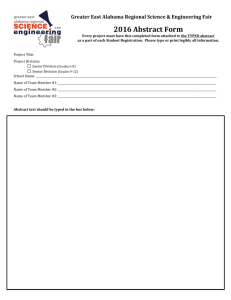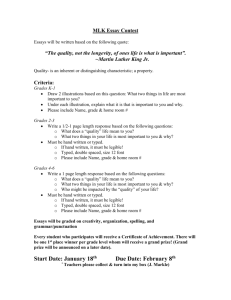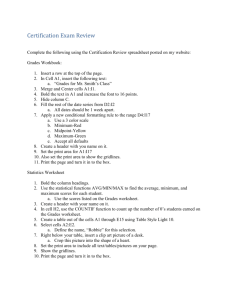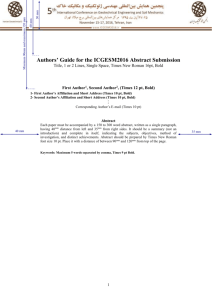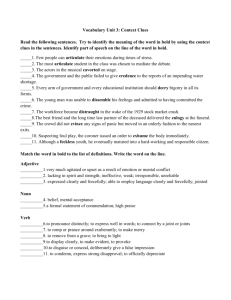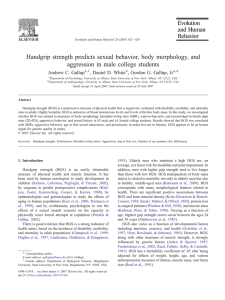ANATOMY & PHYSIOLOGY CLASS: WRITING LAB REPORTS
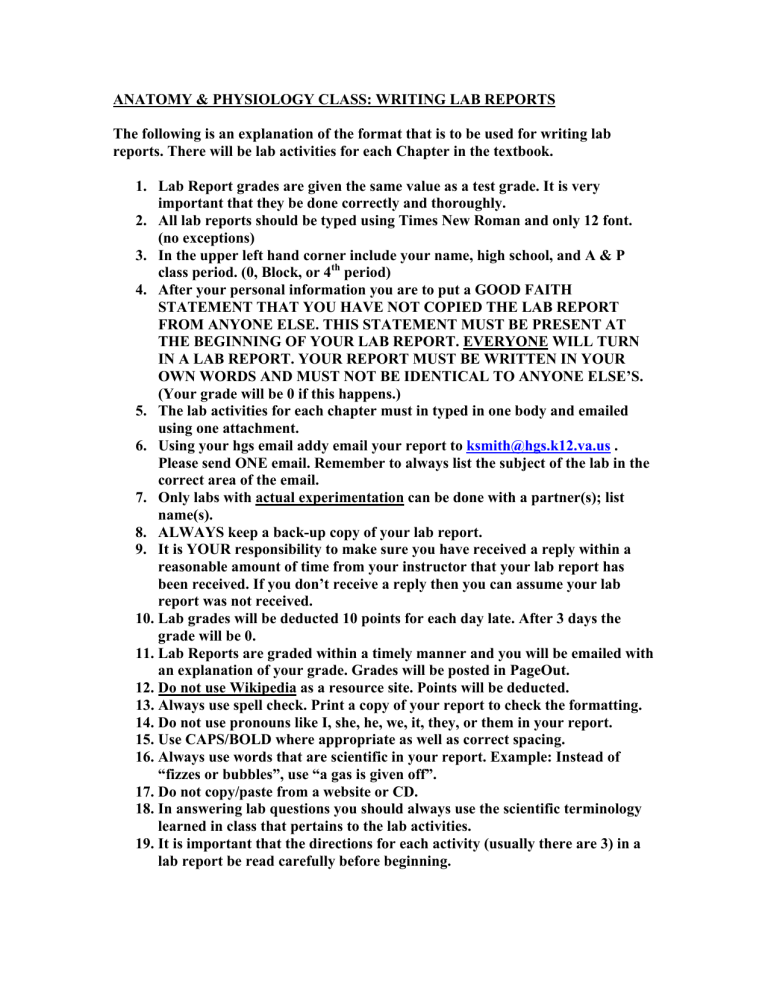
ANATOMY & PHYSIOLOGY CLASS: WRITING LAB REPORTS
The following is an explanation of the format that is to be used for writing lab reports. There will be lab activities for each Chapter in the textbook.
1.
Lab Report grades are given the same value as a test grade. It is very important that they be done correctly and thoroughly.
2.
All lab reports should be typed using Times New Roman and only 12 font.
(no exceptions)
3.
In the upper left hand corner include your name, high school, and A & P class period. (0, Block, or 4 th
period)
4.
After your personal information you are to put a GOOD FAITH
STATEMENT THAT YOU HAVE NOT COPIED THE LAB REPORT
FROM ANYONE ELSE. THIS STATEMENT MUST BE PRESENT AT
THE BEGINNING OF YOUR LAB REPORT. EVERYONE WILL TURN
IN A LAB REPORT. YOUR REPORT MUST BE WRITTEN IN YOUR
OWN WORDS AND MUST NOT BE IDENTICAL TO ANYONE ELSE’S.
(Your grade will be 0 if this happens.)
5.
The lab activities for each chapter must in typed in one body and emailed using one attachment.
6.
Using your hgs email addy email your report to ksmith@hgs.k12.va.us
.
Please send ONE email. Remember to always list the subject of the lab in the correct area of the email.
7.
Only labs with actual experimentation can be done with a partner(s); list name(s).
8.
ALWAYS keep a back-up copy of your lab report.
9.
It is YOUR responsibility to make sure you have received a reply within a reasonable amount of time from your instructor that your lab report has been received. If you don’t receive a reply then you can assume your lab report was not received.
10.
Lab grades will be deducted 10 points for each day late. After 3 days the grade will be 0.
11.
Lab Reports are graded within a timely manner and you will be emailed with an explanation of your grade. Grades will be posted in PageOut.
12.
Do not use Wikipedia as a resource site. Points will be deducted.
13.
Always use spell check. Print a copy of your report to check the formatting.
14.
Do not use pronouns like I, she, he, we, it, they, or them in your report.
15.
Use CAPS/BOLD where appropriate as well as correct spacing.
16.
Always use words that are scientific in your report. Example: Instead of
“fizzes or bubbles”, use “a gas is given off”.
17.
Do not copy/paste from a website or CD.
18.
In answering lab questions you should always use the scientific terminology learned in class that pertains to the lab activities.
19.
It is important that the directions for each activity (usually there are 3) in a lab report be read carefully before beginning.
20.
Most of the lab reports have questions that are matching or completion. The answers to those will be posted in Pageout the day after the Lab Report is due. These will help you review for the chapter tests.
21.
UNLESS otherwise specified all labs will be due 2 days before the Chapter
Test is given. (ie. If the test is on Friday for Chapter 1 then the Lab for that same chapter must be emailed the previous Wednesday by midnight.)
FORMAT FOR A LABORATORY REPORT (Go by this format in writing all lab reports for this course.)
Performing laboratory experiments and making observations is a very important aspect in the study of science, but equally important is the manner in which you record your results. Your laboratory report should cover all the important information related to your experiment or observation. Your lab report should be done in a very neat format . The following is a discussion of the major headings in your lab report. Include all in your report unless otherwise directed. Type each heading in CAPS & USE the Bold.
OBJECTIVE
The objective st atement is a statement that explains the reason for doing the experiment.
You also need to state the biological principles and concepts that are being used. This section of your report needs to be at least 3 sentences .
MATERIALS
The materials se ction of your lab report should be an organized list of materials used for the experiment.
P ROCEDURE
The procedure se ction needs to have a summary of the important activities done during the experiment. You do not need to have the step-by-step procedure; it should be in your own words. Do NOT copy the procedures used in the lab.
ANALYSIS: includes
The analysis section of y our report should be organized prior to performing your experiment, unless directed otherwise. Some or all the following types of information may need to be included in the analysis.
A . OBSERVATIONS
Observations are what y ou observe with your senses during an experiment. Examples of possible observations are changes in physical or chemical conditions. At times drawings or sketches may be needed to further explain your observations.
B . DATA
Any inform ation that is used in determining the results of the experiment is usually classified as data. It is very important that the data collected during the experiment b e properly identified, and that correct significant index digits and units be used. Do not
leave numerical data unsubstantiated. Equipment and instruments must be read to the correct number of significant digits. As a general rule, one estimated digit should be recorded as the final significant digit.
C . TABLES
In many exper iments the amount of information included in your observations and data will be extensive. Tables are a very efficient means of organizing information. Sample tables are provided for some experiments. All information should be clearly labeled.
Whenever there are several calculated values, they should be organized in a table. Tab les must have titles.
C ONCLUSIONS: DO NOT FORGET TO INCLUDE THIS!!
The conclusions section of your laboratory report should thoroughly describe what you discovered during the laboratory experiment or observation. In other words, it is a synopsis of your results. You also need to include how what you did in the lab relate s to what has been discussed in class and use scientific terms learned in class. This must be at least 3 – 5 sentences in length . It may need to be more than one paragraph.
ADDITIONAL QUESTIONS:
Each lab will usually be followed by questions that will be connected with the experiment. You should always type the question in CAPS , using BOLD and t hen provide a thorough answer in regular font (size 12). ALWAYS skip a line between the answer and the question that follows.

